Examples of Art Movements, Design, and Visual Style
Welcome to the examples hub on Paul Artistry. Here you’ll find bite‑size guides that show how big art ideas turn into real‑world work. Whether you’re a student, a creator, or just curious, these examples give you a shortcut to understand the what, why, and how of each topic.
Why Real‑World Examples Matter
Talking about "Expressionism" or "Bauhaus" sounds cool, but without a concrete case it stays abstract. Seeing a painting, a tattoo, or a room that follows a movement makes the theory stick. That’s why each post on this page pairs a short history with practical tips, checklists, and visual cues you can spot in a museum, a gallery, or your own home.
For instance, the Expressionism guide shows how bold colors and distorted forms broke away from realism, and then it points out three modern artworks where you can see that same energy. The Bauhaus article breaks down the "form follows function" rule and then lists three everyday objects—a chair, a lamp, a smartphone case—that embody that rule. You get the story and the proof in one go.
Popular Topics Covered
Our tag collects a wide range of subjects, but a few stand out because they keep popping up in design classrooms and Instagram feeds. Abstract Expressionism gets a deep dive that links Jackson Pollock’s splatters to today’s gestural digital art. Harlem Renaissance pieces show how music, literature, and visual art blended to reshape Black identity, with examples you can find on streaming playlists and museum walls.
If you’re into tattoos, the Art Nouveau tattoo guide walks you through whiplash curves, Alphonse Mucha motifs, and placement advice—so you know what to ask your artist. The Photorealism posts list ten artists whose work looks like a photograph, plus quick tips on spotting the brushwork that makes it real.
Design lovers will appreciate the Avant‑Garde home décor article that shows how to turn a living room into a gallery using bold patterns and unexpected materials. The Futurism and smart cities write‑up explains how futuristic concepts influence city planning, with real‑world projects you can visit online.
Each example post follows the same practical formula: brief history, key characteristics, real‑world case studies, and a quick‑action checklist. That way you can read a summary in five minutes and still walk away with something you can apply tomorrow.
Got a specific project in mind? Use the search bar to filter by keyword—type "Bauhaus", "photorealism", or "installation art"—and you’ll land on the exact example you need. The page is designed for fast browsing, so you spend less time hunting and more time creating.
Bottom line: examples turn theory into practice. Browse, learn, and start applying these ideas right away. Your next artwork, design, or research paper will feel more grounded and a lot more interesting.

